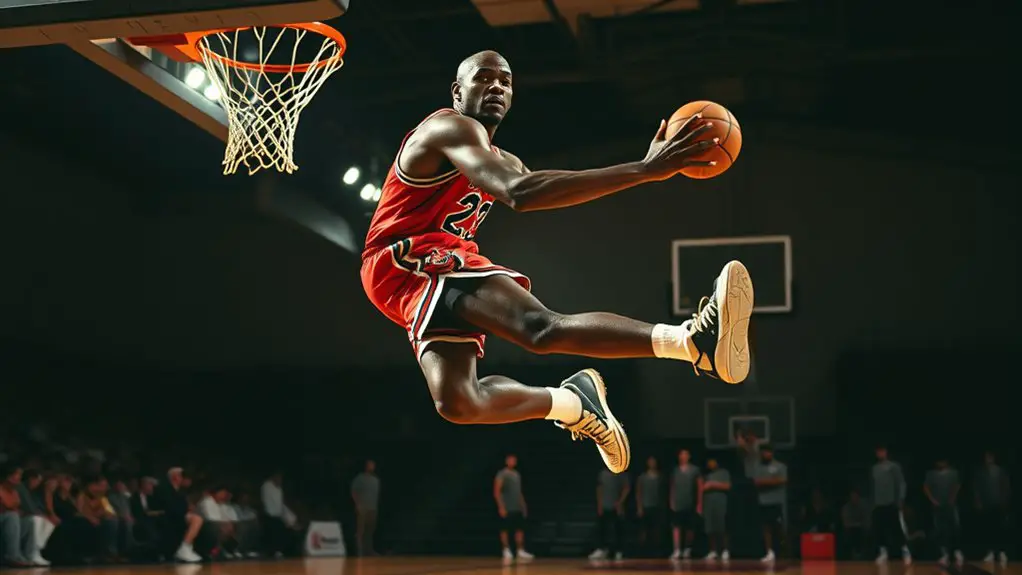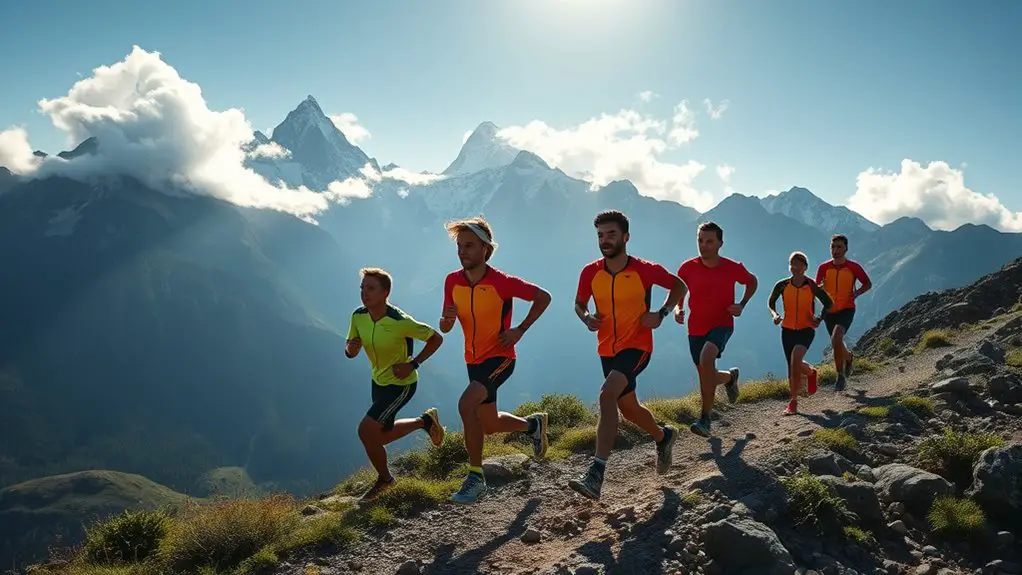To prepare for action roles, you focus on script analysis and character development to understand what drives your character. Customized workout regimens enhance your strength, agility, and endurance through intense training. You master martial arts and incorporate stunt coordination for authenticity in fight scenes. Nutrition and hydration support peak performance, while mental preparation builds resilience. Collaborating with expert trainers helps you embody your role fully. There's so much more to explore about this transformative journey.
Understanding the Role: Script Analysis and Character Development
When preparing for an action role, actors often dive deep into script analysis and character development. You can't just skim through the lines; you need a thorough script breakdown to understand every twist and turn. It's about peeling back layers to uncover character motives that drive your choices and actions.
As you analyze the script, think about the character's background, desires, and conflicts. What fuels their passion? What are they fighting against? This isn't just about memorizing lines; it's about embodying a spirit that resonates with freedom and authenticity.
Customized Workout Regimens
To effectively prepare for an action role, actors often require customized workout regimens tailored to their specific character demands and physical capabilities. You might wonder how they achieve such impressive transformations. The secret lies in personalized fitness plans designed just for them. These plans consider their current fitness level, goals, and the physical traits needed for their role.
Instead of a one-size-fits-all approach, they focus on tailored exercises that enhance agility, strength, and stamina. Whether it's through martial arts, dance, or circuit training, each workout is meticulously crafted.
You'll notice that actors often work closely with trainers who specialize in creating these dynamic routines. This collaboration guarantees every session is engaging and effective, allowing them to push their limits without risking injury. By embracing a customized workout regimen, they not only become their characters but also discover newfound strength and resilience. Incorporating functional strength training into their routines can significantly enhance their overall performance and injury prevention.
Strength Training: Building Muscle and Endurance
While actors often showcase incredible physical prowess on screen, achieving that level of fitness requires intense strength training focused on building muscle and endurance. You'll need to embrace a routine that prioritizes muscle hypertrophy, aiming for those gains that'll transform your physique. This involves lifting heavier weights with lower repetitions, allowing your muscles to grow bigger and stronger.
Incorporating endurance circuits is just as essential. These circuits help you build stamina, enabling you to perform at your best during long shooting days. Picture yourself moving through a series of exercises—think squats, push-ups, and kettlebell swings—without rest, pushing your limits. Adding key strength training exercises, such as deadlifts for overall strength, can further enhance your performance and resilience.
Mixing these elements not only sculpts your body but also empowers your spirit. You'll feel free and unstoppable, ready to tackle any role that comes your way. So, lace up those shoes, hit the gym, and release the action star within you!
Martial Arts and Combat Training
When it comes to action roles, mastering martial arts is crucial for any star. You'll explore various types of martial arts, learn fight choreography techniques, and focus on conditioning to build stamina. Each element plays a fundamental role in creating believable and thrilling fight scenes on screen.
Types of Martial Arts
Martial arts encompass a diverse range of fighting styles, each offering unique techniques and philosophies. If you're looking to build your skills, consider exploring karate techniques for striking, or investigate jiu jitsu styles that focus on grappling. Taekwondo fundamentals can elevate your kicking game, while boxing tactics sharpen your hand speed and footwork. For a fierce stand-up style, muay thai combines powerful strikes and clinches. Krav maga offers practical self-defense strategies, perfect for real-world situations. You might also enjoy the fluid capoeira movements that blend dance with combat. Aikido principles emphasize harmony and redirecting force, while mixed martial arts combines various disciplines for a thorough approach. Embrace your freedom to choose the style that resonates with you!
Fight Choreography Techniques
To create compelling fight scenes, filmmakers rely on intricate choreography that blends martial arts techniques with storytelling. You'll find that various fight styles, from karate to Brazilian jiu-jitsu, play an essential role in shaping these action sequences. Choreography drills help actors master performance techniques, ensuring they can deliver believable and thrilling combat. During rehearsal methods, precision movements are practiced repeatedly, refining each gesture for maximum impact. Stunt execution is crucial, as it keeps everyone safe while maintaining the illusion of danger. Each fight sequence is designed not just to impress but to tell a story, reflecting the characters' emotions and motivations. This combination of artistry and athleticism creates the unforgettable moments we love in action films.
Conditioning and Stamina Training
Conditioning and stamina are essential components for actors preparing for action roles, as they enhance performance and guarantee safety during intense sequences. To truly shine on screen, you need to engage in rigorous cardiovascular conditioning and endurance exercises. Think of high-intensity interval training, running, or cycling; these activities boost your stamina and keep your heart strong. Incorporating martial arts into your routine not only builds strength but also sharpens your reflexes. You'll find that the more conditioned you are, the more freedom you'll experience in your movements, allowing you to perform at your best. With the right training, you won't just survive those action-packed scenes—you'll thrive, bringing authenticity and energy to every fight and chase.
Stunt Coordination and Safety
When it comes to action roles, stunt coordination is essential for keeping everyone safe on set. You'll find that safety protocols during training are just as important as mastering the moves themselves. By understanding these practices, you can appreciate the hard work that goes into each thrilling scene.
Importance of Stunt Coordination
Although many might think that action roles are all about physical prowess, stunt coordination plays an essential role in guaranteeing both safety and authenticity on set. You can't underestimate how significant stunt choreography is in creating impressive sequences while minimizing risks. By implementing effective safety measures, stunt coordinators help performers release their creativity without holding back.
| Element | Importance |
|---|---|
| Stunt Choreography | Enhances visual appeal |
| Safety Measures | Protects performers |
| Coordination | Guarantees smooth execution |
With skilled stunt coordinators, actors can focus on their roles, knowing their safety is prioritized. Ultimately, stunt coordination bridges the gap between thrilling action and secure film production, allowing for the freedom to explore daring performances.
Safety Protocols in Training
While preparing for action roles, implementing robust safety protocols during training is essential for both actors and stunt performers. You want to feel free and confident in your movements, and that starts with knowing you're safe. Here are four key safety measures to keep in mind:
- Always wear appropriate safety gear to protect yourself during stunts.
- Understand and follow emergency protocols for quick response in case of injuries.
- Practice stunts with a trained stunt coordinator to guarantee proper technique.
- Keep open communication with your team to address concerns and adjustments.
When you prioritize safety, you can release your inner action star without unnecessary fear. Embrace the thrill, but remember: your well-being comes first!
Nutrition and Diet Plans
As movie stars gear up for intense action roles, their nutrition and diet plans play an essential role in shaping their physical capabilities. You can't underestimate the power of meal planning and hydration strategies. Fueling your body with the right nutrients and staying hydrated can make all the difference in your performance. Meal timing is also crucial for optimizing energy levels and recovery during intense training.
Here's a simple table to help you visualize what a balanced diet looks like for action-packed roles:
| Meal Type | Foods to Include | Hydration Tips |
|---|---|---|
| Breakfast | Eggs, whole grains, fruit | Drink water first thing in the morning |
| Lunch | Lean protein, veggies | Keep a water bottle handy throughout the day |
| Dinner | Quinoa, fish, greens | Aim for herbal teas in the evening |
Mental Preparation: Focus and Resilience
To excel in action roles, actors must cultivate not only their physical strength but also their mental resilience and focus. You can tap into your inner strength by employing effective strategies to sharpen your mind and manage stress. Here are some powerful techniques you can use:To thrive in action roles, actors must enhance both physical strength and mental resilience through focused strategies.
- Mental Focus: Set clear goals for your performance, enabling you to concentrate on what matters most.
- Resilience Techniques: Practice embracing challenges as opportunities for growth, building your emotional fortitude.
- Visualization Practices: Imagine yourself succeeding in intense action sequences, which can boost your confidence and clarity.
- Stress Management: Incorporate mindfulness and breathing exercises to maintain calm under pressure. Additionally, embracing struggle helps forge mental strength that is crucial in high-stakes performances.
Recovery and Injury Prevention
Since action roles demand intense physical exertion, prioritizing recovery and injury prevention is vital for actors. You've gotta embrace active recovery, which includes low-intensity workouts that keep your body moving without overdoing it. Injury management is key; it involves recognizing potential risks and taking preventive measures to avoid setbacks. Incorporating rehabilitation techniques, like stretching and foam rolling, can greatly aid muscle recovery.
Physical therapy plays an important role too, helping you bounce back faster if injuries do occur. Staying in tune with your body enhances injury awareness, allowing you to adjust your training when necessary. Establishing wellness routines, such as proper nutrition and hydration, further supports your recovery process. Additionally, proper hydration strategies help replenish lost fluids and electrolytes, promoting quicker muscle recovery. Remember, prioritizing these elements not only helps you stay in shape but also keeps you performing at your best when the cameras roll. So, listen to your body and make recovery a priority!
Collaboration With Trainers and Coaches
While pursuing demanding action roles, collaborating with trainers and coaches becomes essential for actors aiming to reach peak performance. This trainer collaboration is more than just physical conditioning; it's about unveiling your potential and embracing freedom in movement. Here's how that partnership can transform your journey:
- Personalized Training Plans: Tailored workouts align with your unique strengths and weaknesses.
- Expert Guidance: Coaches provide insights that help you avoid common pitfalls and injuries.
- Real-Time Feedback: Constant coach feedback keeps you motivated and on track, enhancing your performance.
- Mental Resilience: Trainers help you develop the mindset needed to overcome challenges and embrace every action scene with confidence. Additionally, embracing focus techniques can significantly enhance your performance and help you fully embody your character.
Transformative Journeys: Before and After Comparisons
When actors commit to action roles, the transformation they undergo can be nothing short of remarkable. You might've seen the dramatic physical transformations of stars like Chris Hemsworth or Gal Gadot, who shed or gained weight, built muscle, and honed their skills to embody their characters authentically. These celebrity comparisons highlight not just their physical changes but the mental fortitude required to achieve such feats.
Imagine the discipline it takes to wake up at dawn for grueling workouts or to stick to a strict diet. It's about embracing freedom through hard work, pushing boundaries, and redefining oneself. You witness their journey in before and after photos, where each snapshot tells a story of dedication and resilience. The allure of action roles isn't just the stunts; it's the inspiring evolution that captivates us, showcasing how anyone can transform with the right mindset and commitment. Additionally, strong core muscles enhance stability and coordination, allowing actors to perform complex stunts with confidence and precision.
Frequently Asked Questions
How Long Do Actors Typically Train for an Action Role?
You'd think actors just show up and start kicking butt, right? Well, in reality, they often spend weeks, sometimes even months, on intense training regimens to prepare for action roles. It's all about those preparation timelines, which vary based on the role's demands. You might be surprised how much effort goes into looking effortless! But hey, when you're chasing freedom in an epic film, it's all worth it, isn't it?
Do Actors Use Special Supplements During Their Training?
Actors often use various supplement types during their training to enhance performance and recovery. You might see them incorporating protein powders, creatine, or amino acids into their training diets to support intense workouts. These supplements can help boost energy levels and aid muscle repair. While it's important to focus on a balanced diet, the right supplements can give you that extra edge, allowing you to release your potential and achieve your fitness goals.
What Role Does Genetics Play in an Actor's Physique?
Genetics can shape an actor's physique like a sculptor chiseling a block of marble. Your genetic predisposition influences body composition, determining how easily you build muscle or lose fat. If you've got a naturally lean frame, it might be easier for you to achieve that action hero look. However, hard work and dedication can still lead to impressive results, regardless of your genetic starting point. Embrace your body and make it your own!
How Do Actors Manage Time for Training Alongside Filming?
You might wonder how actors juggle training schedules alongside filming. It all comes down to effective time management. Many stars prioritize their workouts, often fitting them in early mornings or late nights. They know the importance of maintaining their fitness while balancing intense shooting days. By creating structured routines, they can carve out time for both roles—acting and training. This flexibility allows them to stay in peak condition without sacrificing their creative freedom.
Are There Differences in Training for Different Action Genres?
When it comes to training for different action genres, there're subtle variations that make each experience unique. For instance, if you're diving into a martial arts film, you'll focus on fight choreography and precision. On the other hand, a superhero flick might have you embracing stunt coordination, blending acrobatics with strength. Each genre invites you to explore your limits while keeping the thrill alive, giving you the freedom to express your physicality in diverse ways.




